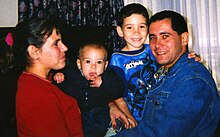Balsero
The term Balsero - it is derived from the Spanish-language word balsa from for "raft" and should be translated roughly as "rafters" - to use for those Cubans who try to Florida street to cross from Cuba and the coasts of the United States to to seek a better life there. Many lost their lives in the process. Usually people fled for economic rather than political reasons.
When asked for their reasons, most of the balseros tried to explain their escape with the political conditions and the difficult economic situation in their home country, Cuba. The opponents of Castrism , the politics of Fidel Castro , cited the bad form of the government of the current leadership as the main reason for their flight as well as the socialist system that had ruled for decades ; the sympathizers of Castrism made the United States embargo against Cuba , which has been in effect since 1960 in force is responsible for their troubles. This blockade prohibits economic transactions between the US and Cuba, as well as those of foreign companies controlled by US Americans.
The escape of Cubans who disagree with their government is normal. Another reason could be the North American policy regarding family visits and gifts from emigrants already in the US and their family members in Cuba, although money transfers are allowed. Other reasons are clearly economic: just like the Mexicans who emigrate to the USA via the Río Grande , Africans to southern Europe or the Asians to Japan.
The US government's stance on Cuban refugees is complex. The policy called Wet feet, dry feet policy allowed those Cubans who make it to US soil ( dry feet ) to stay in the US and those who intercepted off the coasts of the USA ( wet feet ) must return to Cuba. Many balseros who fled to other countries such as Mexico , the Bahamas or Honduras in their zeal were mostly brought back to Cuba. The regulation was abolished in January 2017.
The Elián González case
One of the best-known balseros was the then six-year-old boy Elián González, whose mother was killed while fleeing towards Florida . The case grew into bilateral tensions between the United States, where the boy was staying with his mother's relatives, and the Cuban government, which demanded the boy's return to his father, who was still living on the island.
In both Florida and Cuba there were rallies every Saturday and every holiday calling for the boy to be "liberated". On the orders of the US Attorney General Janet Reno , the SWAT special unit took the boy out of his relatives' home in Miami after they refused to surrender him voluntarily. Elián was turned over to the Cuban authorities, who took him to his father.
Other notable cases
Perhaps the most attention-grabbing single incident occurred in 2003 when a dozen or so Cubans attempted to reach the coast of Florida in a 1951 Chevrolet . To make the truck seaworthy, the truck was equipped with several empty tanks. The vehicle was propelled by a small ship's propeller, which could probably reach a speed of seven knots (13 km / h). The "truck balseros" were discovered by the US Coast Guard around 65 kilometers south of Key West and returned to Cuba. The amphibious vehicle was sunk in the sea so that, the US federal authorities said it could not serve as a memorial to anyone who might want to flee from Cuba. A little later there was a similar escape attempt, this time in a Buick built in 1959.
Movies
- 2002: Balseros , documentary about the Balseros
- 2012: Una Noche - One Night in Havana , docudrama about three Cuban teenagers who want to flee
See also
Web links
- Cubanos sin Fronteras
- Situation de los balseros cubanos
- The Cuban Rafter Phenomenon , University of Miami
Individual evidence
- ↑ Cuban Embargo May Hold Hidden Perils for Unwary Mining Companies , Jeffrey L. Snyder & James W. Reed in: Crowell & Moring Mining Law Monitor, 2/2010
- ↑ SPIEGEL ONLINE, Hamburg Germany: "Wet foot, dry foot": Obama ends exception regulation for refugees from Cuba - SPIEGEL ONLINE - politics. In: SPIEGEL ONLINE. Retrieved January 13, 2017 .
- ↑ Floating Cubans

